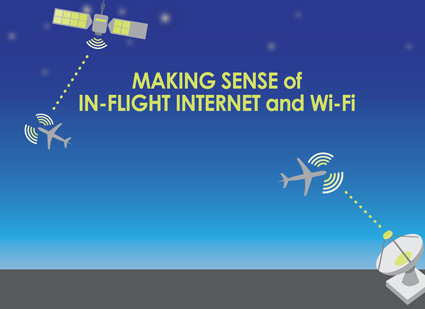"SOME UPGRADES CAN REUSE 75% OF AN AIRCRAFT’S EXISTING EQUIPMENT."

High-speed internet access is a way of life for many people. In today’s environment, it isn’t unusual for individuals to be tasked with multiple responsibilities, and key people need to stay connected.
"I remember talking to CEOs not that long ago who told me the time they spend en-route was their time, a time to unwind or a time to prepare for the task that was waiting for them at their destination," says Gary Harpster, Avionics Installations Sales Rep at Duncan Aviation’s Lincoln, Neb., facility. "These same CEOs are now asking for the ability to check their messages en-route and stay up-to-speed on new developments. We’re a mobile society, but we need to stay connected."
Smartphones, Blackberrys, PDAs and laptops have all become tools of the trade. Selecting an aircraft high-speed data (HSD) system is not unlike choosing a cell phone or internet access provider. Data connection speed, network availability, equipment costs and subscription plans all factor into the equation. Options abound, as does confusion about those options.
Most of the confusion seems to be with terminology, particularly the difference between "HSD" and "Wi-Fi."
"HSD is the data pipe to the aircraft, says Steve Elofson, Avionics Installation Sales Manager at Duncan Aviation-Lincoln. "Wi-Fi connects to that data pipe wirelessly."
Steve explains that Wi-Fi is essentially a wireless network, internal to the aircraft. Like any home internet wireless router connection, people can connect their laptop to the internet with a hard line, or if a wireless router has been installed, they can connect wirelessly.
"There are wireless routers certified for aircraft use while in flight," says Steve. "These interface with the HSD equipment to provide Wi-Fi onboard an aircraft. Current Federal Aviation Administration (FAA) requirements state that wireless routers need to be installed via Supplemental Type Certificate (STC)."
There are several HSD solutions available for aircraft owners and operators, with several equipment and service providers vying for their attention. The critical factors to keep in mind when selecting a solution are the passenger’s needs, speed, accessibility and availability.
A ground-based solution provides the fastest connection speed, operating very much like what a person would experience in a home or office environment. However, this solution doesn’t activate until an aircraft is above 10,000 feet and is only available within the continental United States.
"It doesn’t take a corporate jet very long to reach 10,000 feet, only a few minutes," says Gary. "This isn’t a bad thing. There is something to be said that at that point in the flight, passengers should be buckled in and listening to the safety briefings."
Satellite-based solutions offer slower connection speeds, but with greater accessibility and wider availability. These solutions offer a connection during all phases of flight with very few geographical limitations. This functionality is achieved by communication with satellites stationed above the equator in a 23,000-mile orbit.
"This system requires an antenna mounted on top of the aircraft, the tail or along the fuselage," says Gary. "Some aircraft don’t have enough real estate to handle a fuselage-mounted antenna, and current FAA requirements state that these antennas need to be installed via STC."
"SOME UPGRADES CAN REUSE 75% OF AN AIRCRAFT’S EXISTING EQUIPMENT."
Upgrade paths can also help narrow the decision. The majority of an aircraft’s existing equipment can be left intact, helping to reduce costs and downtime.
"Customers need to take into consideration what their aircraft currently has," says Gary. "Some upgrades can reuse 75% of an aircraft’s existing equipment."
There are lots of variables to consider. Although the FAA is making progress with guidelines and documentation, keep in mind this is a fairly new technology to the world of aviation.
Duncan Aviation’s Avionics Installation Sales Reps maintain strong manufacturer relationships and stay in contact with the FAA on developing issues. Talk to our experts for their thoughts on what to consider, or ask them to help you find a solution that meets your needs.
Where you operate and the amount of data you intend to move will generally dictate which high speed data (HSD) system will have the most utility for your passengers. Below are three HSD solutions, with countless additional options to make your cabin network the most useful for your specific needs.
Aircell Broadband is for operators whose operations are restricted to the lower 48 states. Aircell’s Broadband (air to ground) System provides fast connection speeds with two different data rate services available with unrestricted monthly use; 500 Kbps and 3.1 Mbps pipelines. Currently, Aircell is in negotiations with Mexican Authorities to create a similar network there and is looking into the possibility of a Canadian network to cover the northern flight routes. There is no current timeline for completion of these networks.
KU Broad Band is available from Viasat and Rockwell Collins. Viasat is currently partnered with Satcom Direct’s Yonder service and Rockwell Collins is partnered with Arinc Direct’s Skylink service. KU Band terminals are designed for the flight department that demands the best performance that their equipment can offer with the fastest download speeds of any HSD system with 30 Mbps down and 1 Mbps up. While service coverage is international, it is not yet global. Additions to its coverage areas, tentatively scheduled for 2010, will expand coverage to most global flight routes and geographic regions.
SwiftBroadband (SBB) provided by Inmarsat offers an excellent mix of speed and coverage. The Inmarsat I-4 satellites offer truly global coverage. Only the Arctic and Antarctic regions are outside the coverage area. Typical connection speeds are 350-432 Kbps from ground to aircraft. This can be raised to 600-1100 Kbps by using an accelerator such as EMS’s CNX-200 along with Satcom Direct’s Aero-X service. In addition, several manufacturers offer SBB upgrades to existing systems, minimizing invasiveness and cost of installation.
For more solutions, call our Lincoln, Nebraska facility at 800.228.4277 (402.475.2611) or our Battle Creek, Michigan facility at 800.525.2376 (269.969.8400) and ask for an Avionics Installation Sales Representative.